Create
Vintage St. Pete: The Don CeSar (Part II)
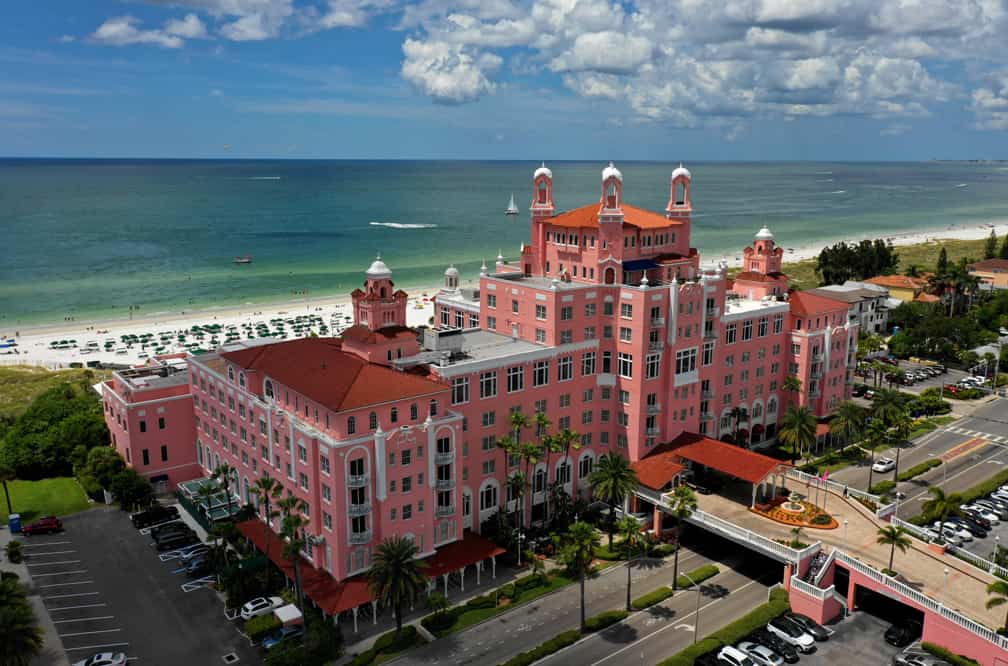
Part 2 of 2
Mary Lucille Rowe lost the Don CeSar when the United States government exercised its power of eminent domain – the legal right to take possession of private property by paying its assessed value.
The government planned to convert the aging hotel into an Army hospital; Rowe was given $440,000 and told to go away. It was wartime, and she had no say in the matter.
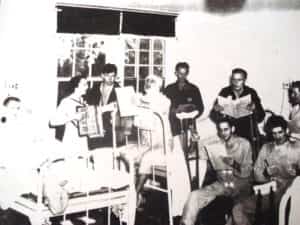 After another $200,000 in renovations, including tearing out guest room walls to create wards, re-making the grand ballroom as a movie theater and turning the tony 8th floor suites into operating rooms, the Don Ce-Sar Hospital opened in the fall of 1942. But the patient load was great, overwhelming the dedicated staff, and it soon became apparent that the old building was impractical for such use. In June 1943, 1,800 sick calls were logged in daily from bases in St. Pete, Clearwater and Belleair, according to a report in the hospital newsletter, the Don Roger.
After another $200,000 in renovations, including tearing out guest room walls to create wards, re-making the grand ballroom as a movie theater and turning the tony 8th floor suites into operating rooms, the Don Ce-Sar Hospital opened in the fall of 1942. But the patient load was great, overwhelming the dedicated staff, and it soon became apparent that the old building was impractical for such use. In June 1943, 1,800 sick calls were logged in daily from bases in St. Pete, Clearwater and Belleair, according to a report in the hospital newsletter, the Don Roger.
The United States Army Air Forces moved in for a few months, tending to the health needs of the fliers in training at Tampa’s MacDill base and its St. Petersburg counterpart, the Pinellas Air Base (current site of the St. Pete-Clearwater International Airport). For this, the Don proved to be simply too big, and the Army Air Forces were forced to pivot in an entirely different direction.
It’s a wise decision of the Army to make the Don Ce-Sar hotel a convalescent center for wounded and exhausted combat fliers and crewmen. The sun and sand and surf are great healers to body and soul and spirit. Pinellas County will welcome this opportunity to aid in any way the few to whom so many are indebted.
St. Petersburg Times editorial/March 4, 1944
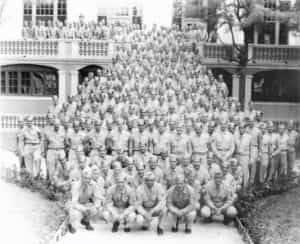 According to historian June Hurley Young, the AAF Convalescent Center was the brainchild of General N. W. Grant, who saw the need for a centralized location for the psychiatric and physical rehabilitation of battle-fatigued airmen, whose care had been spread between six bases around the country.
According to historian June Hurley Young, the AAF Convalescent Center was the brainchild of General N. W. Grant, who saw the need for a centralized location for the psychiatric and physical rehabilitation of battle-fatigued airmen, whose care had been spread between six bases around the country.
“The Don was perfectly suited for its new role because of its fine recreational facilities, the salubrious climate of Florida’s Gulf Coast and the ease with which hotel facilities could be converted to serve the patients,” Young wrote in The Don CeSar Story.
“We actually refer to this period as the golden years,” says Don CeSar Resort director of marketing Todd Gehrke. “It was a pretty amazing story, of coming here and recovering from PTSD.
“There were a lot of Red Cross folks who married guys from the service. People from the community are constantly telling me ‘My grandparents were married there!’ or ‘My aunt and uncle were married there!’”
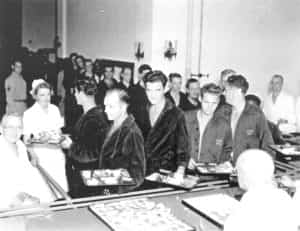 Capacity at the AAF Convalescent Center was 650 patients; only men suffering from overseas combat fatigue were admitted; after six to eight weeks of treatment, relaxation, team sports and camaraderie they’d be re-assessed and either sent back to the war (sometimes in new, non-combatant roles) or returned to their civilian lives.
Capacity at the AAF Convalescent Center was 650 patients; only men suffering from overseas combat fatigue were admitted; after six to eight weeks of treatment, relaxation, team sports and camaraderie they’d be re-assessed and either sent back to the war (sometimes in new, non-combatant roles) or returned to their civilian lives.
During an October WSUN radio broadcast, commanding officer Richard E. Elvins talked about the non-medical aspects of life at the Don. “The convalescent training program offers a variety of classes and subjects in which every returnee must take part,” he said. “There is photography, woodworking, radio mechanics, news analysis, journalism, AAF administration and a hobby shop. If the patient shows an interest in any of these things, the program is quick to cultivate that interest.
“Many of the instructors are returnees themselves from combat. They know how difficult it is to relax after months of actual fighting overseas, and for that reason the classes aren’t all-day lectures but periods where he can move about and do things if he wishes. He builds boats and radio sets. He sees entertaining movies with quite a few Donald Duck cartoons thrown in for good measure. He writes stories, and gets black and greasy while mounting an airplane engine on a test block. And what’s more important, he likes it!”
Athletic opportunities, the C.O. added, included competitive baseball, tennis, badminton, volleyball and more. St. Petersburg clubs assisted with bowling, golf, riding and fishing excursions. “And the Red Cross is right in there with dances, picnics and informal parties.”
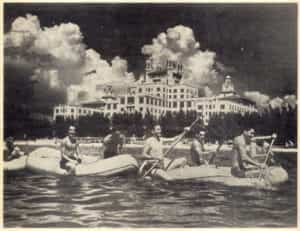
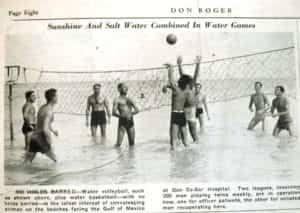

The Japanese surrendered on Aug. 18, 1945, marking the end of World War II (Germany had thrown in the towel in May). On Sept. 22, the War Department announced the imminent closure of the convalescent center at the Don Ce-Sar; the 350 patients remaining would be transferred to a facility in Texas.
After a failed bid by the Florida Tuberculosis Board to turn it into a sanitarium, Thomas J. Rowe’s sand castle – still a faint pink in color – became a regional office for the U.S. Veterans Administration. By December employees, desks, filing cabinets and paperwork from the downtown office, and from the Bay Pines V.A. Center, were relocated to the building. The interiors were painted government green as America settled into the post-war era.
Former GIs and their families went to the Don to apply for government benefits and loans, or to seek medical assistance at the outpatient clinic. Under the auspices of the Government Services Agency (GSA), the building came to house other official agencies including the U.S. Fish & Wildlife Service.
In May, 1969, the GSA declared the Don Ce-Sar government surplus and put it up for sale; all in-house agencies had already been re-located to a new federal building downtown.
After 24 years of government service, the Don was abandoned. A chain-link fence was erected around the perimeter to keep undesirables out.
The Don Ce-Sar, still owned by the federal government, has yet to find a new owner. Its once-proud façade is now cracking pink paint, with boarded over windows, a few broken, and an occasional phrase like “pigs were here” scrawled across one of its many doors … “We are very hopeful in the near future we can dispose of it,” said W.W. Barron of the Government Services Agency Business Center in Atlanta. “Every effort is being made.”
St. Petersburg Times/April 12, 1970
June Hurley Young was concerned that the building, a landmark she knew and admired, would be declared a safety hazard, superfluous to current needs, and torn down by whomever bought it from the GSA. Young, who had hosted the tiny-tot TV show Romper Room for many years on Tampa Bay TV, formed a “Save the Don” committee and set about getting the attention of the government – and, crucially, the media.
One of Hurley’s published articles (Pink Elephant or Sleeping Beauty?) caught Missouri hotelier William Bowman’s eye. Bowman, who owned the franchise on more than a dozen Holiday Inns (including the St. Petersburg Beach location) and numerous Lums restaurants, had been looking for a unique hotel in which to invest, “a new kind of challenge.”
Through the tireless back-office machinations of Young and her committee, the City of St. Petersburg Beach purchased the Don in early 1972, and in a pre-arranged move, handed the keys to William Bowman. His purchase price was $460,000.
One of his first gestures as owner was to remove the hyphen from the building’s name. The Don Ce-Sar would henceforth be the Don CeSar.
It would take Bowman 18 months and more than $3 million to restore the hotel to its former opulence. “He gave pretty much everything he had to try to get the place up and running,” explains Gherke. “He was committed to getting it back to what it was, and everything that it represented.
“Rather than just ripping things out and replacing it, he had guys take out every single pane of glass, and repair every single wooden window. He restored all these things that were traditionally in place.”
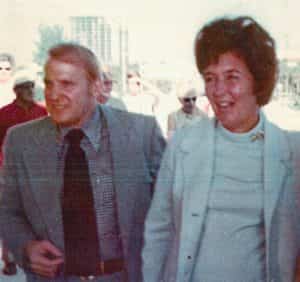
Bowman and Young at the grand re-opening, Nov. 24, 1973.
Bowman air conditioned all the floors, and replaced the plumbing. He put in balconies, a tennis court and a swimming pool. He had all the woodwork restored or replaced, the grand staircase, the lobby fountain. Brass fittings and metalwork. Tiles and sconces. Chandeliers. Fabrics and carpets. It took 12,000 gallons of fresh pink paint to cover the façade.
Bowman was also responsible for building a 152-foot overpass over Gulf Boulevard, conveniently connecting guests with the parking lot he’d had installed.
Opening day was Saturday, Nov. 24, 1973; dinner was served for 600. A splendid time was had by all.
Two years later, as the ink was drying on the proclamation adding the Don CeSar to the National Register of Historic Places, Bill Bowman, deeply in debt, lost the property to his mortgage holders. It was also reported that Bowman owed $170,000 to the IRS.
Although Bowman was permitted to stay on as hotel manager, “the Don kind of ruined him, honestly,” according to Gehrke. “He was always under water, just based on what he spent and what it took to get it rolling.”
RELATED STORY: The Don CeSar, an all-star cast and ‘The world’s worst movie’
RELATED STORY: Tom Petty, MTV and the Don
In the intervening years, the Don CeSar has changed hands several times – each new hotelier upgrading it to more modern, and more luxurious, appointments. In 1989, it was named to the National Trust’s Historic Hotels of America list.
Today’s Don is owned and operated by Pivot Resorts and Hotels, which has just completed more massive upgrades and renovations, a project that includes significant work on Bowman’s 1973 Gulf Boulevard overpass and front drive.
It’s yet another step on a very long and ongoing journey.
I do not want my hotel slapped together hurriedly to meet this winter’s demand. I do want it to be distinctive and different and I want the work executed properly. If it is completed for the season of 1926, I shall be satisfied.
Thomas J. Rowe in the St. Petersburg Times/Aug. 23, 1925
Read Part One here

The Don CeSar Resort today. This photo and all historical images provided by Bread and Butter Public Relations







